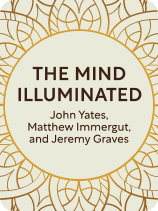

This article is an excerpt from the Shortform book guide to "The Mind Illuminated" by Culadasa, Matthew Immergut, and Jeremy Graves. Shortform has the world's best summaries and analyses of books you should be reading.
Like this article? Sign up for a free trial here.
How can you become an enlightened meditator? How can The Mind Illuminated book help you achieve mindfulness?
The Mind Illuminated is a guide on achieving mindfulness so you can reduce stress in your life. Whether you’re an expert in meditation or want to get started, you can use The Mind Illuminated‘s practices to achieve serenity.
Read below for a brief overview of The Mind Illuminated.
Breaking Down The Mind Illuminated
Many people frame meditation as a way to reduce stress, feel calm, or be more present—but according to The Mind Illuminated book, these aren’t its main goals. Instead, the authors argue, meditation is primarily a way to train your mind so you can experience enlightenment: a mental state that provides freedom from suffering. By following the recommendations outlined in The Mind Illuminated, you can journey from novice meditator to enlightened meditator in 10 sequential stages.
The Mind Illuminated (often referred to by its adherents as TMI), published in 2015, has three authors. The first is Culadasa (John Yates), a former professor in physiology and neuroscience who served as an ordained meditation master before passing away in 2021. Culadasa’s co-authors, Matthew Immergut and Jeremy Graves, are dedicated meditators and his former students. Culadasa, Immergut, and Graves wrote TMI to serve as a comprehensive, secular guide to meditation for readers with any level of experience. The book integrates teachings from many branches of Buddhism and supplements them with ideas from neuroscience.
What Is Meditation?
According to the authors, meditation is training yourself to experience mental states that improve your life. A mental state is a way of perceiving and experiencing the world.
Meditation has roots in Buddhism. More than two millennia ago, the Buddha introduced meditation as a pathway to experiencing enlightenment—freedom from suffering. Since then, Buddhist teachers and scholars have further developed Buddhism by reorganizing and adding to the Buddha’s teachings.
The authors note that meditators experience three important mental states:
Mental State 1: Concentration
According to the authors, samādhi—also known as concentration—involves controlling what to focus on and how long to focus on it. We’ll call what you focus on your focal point.
Concentration is likely something you already do in everyday life—for instance, you might concentrate on listening to an album. When you practice meditation, you strengthen your ability to concentrate on your chosen focal point even as distractions threaten to steal your attention.
(Shortform note: The authors primarily use the term “stable attention” to describe this mental state, emphasizing both the act of focusing (“attention”) and the ability to sustain that focus (“stable”). In this guide, we instead use the term concentration. This term—one you likely already use in everyday life—emphasizes the authors’ point that everyone already has some degree of experience achieving this mental state. Realizing this may make the earliest steps of meditation less daunting.)
When cultivating concentration, most meditators choose their breath as their focal point. Novice meditators often find that distractions such as sounds, bodily sensations, and memories make it hard to sustain their focus on their breath. However, as they hone their concentration skills, they’re eventually able to focus on it for long periods of time.
Mental State 2: Mindfulness
Sati—also known as mindfulness—is an advanced type of concentration. The authors say that you’re in a state of mindfulness when these two conditions are true:
- Your concentration on your focal point is strong, meaning you observe or experience it deeply. For instance, strong concentration on your breath might involve noticing subtle sensations, like the feeling of air passing over the roof of your mouth.
- While you maintain your strong concentration, what we’ll call your background awareness is also strong. This is your awareness of sensations and mental experiences beyond your focal point, such as memories, emotions, smells, and sounds.
By saying that mindfulness involves both strong concentration and strong background awareness, the authors advocate for balancing these two types of attention.
According to the authors, when you’re in a state of mindfulness, you experience the benefits of strong concentration and the benefits of strong background awareness. Think of this as experiencing both depth and breadth. Strong concentration on one focal point provides depth—detailed, thorough observation of a single thing. By contrast, strong background awareness provides breadth—a full picture of your present experience.
Mental State 3: Enlightenment
According to the authors, enlightenment (also called bodhi, awakening, and liberation) is the most important mental state and the ultimate goal of meditation. Like how mindfulness requires strong concentration, enlightenment requires strong mindfulness. As you strengthen your mindfulness, you experience what the authors call insights (vipassanā): epiphanies that dispel your illusions about life, revealing how it really is. These insights, which we’ll call “realizations,” enable you to reach enlightenment.
How to Meditate
Now that we’ve explored what meditation is and how it benefits you and others, we’ll discuss how to meditate effectively. The authors insist that anyone can learn to meditate and achieve enlightenment. Doing so doesn’t require any special skills or background knowledge; it only requires perseverance.
In TMI, the authors organize the journey from novice meditator to enlightened meditator into 10 sequential stages. For simplicity, we’ve grouped these stages into four phases. In Phase 1, you’ll focus on building a meditation routine. In Phases 2 and 3, you’ll cultivate strong concentration and mindfulness, respectively. Finally, in Phase 4, you’ll achieve enlightenment.
Phase 1: Build a Meditation Routine
According to the authors, a consistent, regular routine is essential for successful meditation. Meditation is a skill that requires regular practice, like playing basketball: If you don’t establish a daily practice, you might not advance past its early phases.
We’ll begin this section by describing the basic meditation the authors recommend, which forms the foundation for every session in the four phases. Then, we’ll explore two of the authors’ tips for ensuring this basic meditation is one you’ll practice regularly.
The Basic Meditation
According to the authors, any time you sit down to meditate, you must first take time to ease in both physically and mentally. This preparation reduces the chances that you’ll face distracting sensations, thoughts, and feelings during your basic meditation.
First, ease into your meditation session physically by finding a stable, comfortable position on a chair or the floor. If you choose the latter, cross your legs or tuck your ankles under your opposite leg’s knee or thigh. These poses provide stability so you’re less likely to adjust your position (which would be distracting). Next, straighten your back so your head and neck are aligned. This position minimizes neck and back pain, which in turn minimizes distraction. Finally, keep your eyes closed, especially if you’re new to meditation—this also makes it easier to avoid distractions.
Next, the authors recommend mentally preparing for meditation by reflecting on two questions:
- What’s your goal for this meditation session? Setting a small, achievable goal before you meditate (such as “focus on pleasurable sensations”) prevents you from setting an unreasonable goal you’ll have trouble achieving (such as “ignore all distractions”).
What distractions might get in the way of that goal? For instance, a work-related worry might be likely to distract you. Mentally listing such distractions in advance makes it easier to recognize them as distractions so you can refocus on your focal point.
The Five-Step Basic Meditation
Once you’ve eased into your meditation session, you’re ready to begin the basic meditation that you’ll continue practicing through all the phases. According to the authors, this meditation helps you cultivate strong concentration and mindfulness. As previously noted, both of these mental states improve your life and are essential for reaching enlightenment. We’ve organized the authors’ basic meditation into five steps that have you progressively narrow your focal point while maintaining background awareness.
Step 1: Make sensory input in the present moment your focal point while maintaining background awareness of everything else. For instance, focus on the smell of the room and the air’s temperature. If something in your background awareness (anything that’s not sensory input in the present moment) grabs your attention, such as a thought about something on your to-do list, simply notice it. Then, gently return your attention to your focal point.
Step 2: Make bodily sensations your focal point while maintaining background awareness of everything else. For instance, notice your heartbeat. Once again, if something in your background awareness grabs your attention—such as a sound, smell, memory, or thought—simply notice it, then gently return your attention to your focal point.
Step 3: Repeat Step 2, with one difference—make any breath-related sensations your focal point. For instance, notice the feeling of your stomach touching your shirt as you exhale. Keep your breathing natural while doing this.
Step 4: Repeat Step 3, but with a narrower focal point: breath-related sensations in your nose. You may find this easiest if you breathe only through your nose, as the high volume of air passing through your narrow nostrils will produce subtle but noticeable sensations.
Step 5: Maintain Step 4 for the duration of your meditation session (15 or more minutes).
Tips for Building a Successful Meditation Routine
According to the authors, the best way to ensure you meditate regularly is to schedule daily meditation time. When you’re new to meditation, aim for 15-minute sessions. After a week or two, increase this duration by five minutes every few days until you’ve exceeded 45 minutes.
Additionally, the authors recommend scheduling your meditation session at the same time every day—this makes it an automatic habit. By contrast, if you leave the time of your meditation session up to how you’re feeling, you might procrastinate or avoid it altogether. Pick and stick with a time of day when you’re typically alert and calm so that you don’t fall asleep or get distracted by frantic thoughts. Then, once you’ve picked the ideal time to meditate, protect it: Don’t schedule other commitments at that time.
If you find it hard to maintain a daily meditation routine, you may assume you’re undisciplined and need stricter routines. However, the authors insist that strict discipline will associate meditation with negative feelings, which will make you avoid it.
Instead, see your struggle to maintain a routine as a sign that you need motivation. To boost your motivation, make meditation more enjoyable so you’ll want to meditate daily. One way to do so is to find meditation-related inspiration: Talk to experts, listen to a podcast about meditating, and research the benefits of meditation. Another option is to fixate on feelings of pleasure while meditating. For instance, enjoy the feeling of calmness you experience. You’ll start looking forward to meditating so you can re-experience these pleasures.
Phase 2: Achieve Strong Concentration
Once you’ve established a meditation routine that you regularly follow, it’s time to improve your meditation skills. In this second phase, you’ll work on achieving strong concentration—and to do so, you must overcome the habit of daydreaming (what the authors call “mind-wandering”). Daydreaming is when something in your background awareness captures your attention, causing you to lose concentration on your breath. For instance, the sound of a distant lawn mower might remind you that you need to mow your lawn, which might remind you of all your other chores—and before you know it, you’ve forgotten your breath.
During this phase, aim to minimize daydreaming so it never lasts more than several seconds per meditation session.
Let’s explore two of the authors’ tips for overcoming daydreaming.
Tip 1: Use Positive Reinforcement
When you meditate and you begin daydreaming, there’s typically a moment when you suddenly realize your mind has wandered. The authors explain that the seconds leading up to this moment aren’t in your conscious control. So how do you consciously try to minimize daydreaming when realizing you’re daydreaming is an unconscious process?
According to the authors, by using positive reinforcement, you can consciously train your subconscious mind while meditating. Any time you’re meditating and you suddenly realize you’ve been daydreaming, enjoy it. Congratulate yourself for having this revelation and delight in how it feels to be present again. Over time, this repetitive positive reinforcement will train your subconscious mind to awaken from daydreaming more frequently.
Tip 2: Categorize Your Thoughts
A second way to overcome daydreaming is to categorize all of your thoughts (a practice the authors call “labeling”). Categorizing a thought as soon as it surfaces prevents it from continuing or evolving into a new thought. This interruption halts your daydreaming so you can return to concentrating on your breath.
Additionally, make these categories neutral—this prevents you from judging your thought as “good,” or “bad,” which might spawn more thoughts about its goodness or badness. For instance, mentally reviewing your chores is “list-making”, remembering yesterday’s weather is “recalling”, and thinking about how to ask your boss for a raise is “brainstorming.”
Phase 3: Achieve Strong Mindfulness
So far, we’ve discussed how to achieve strong concentration while meditating. As previously noted, strong concentration is half of mindfulness—the other half is strong background awareness. In this phase, you’ll strengthen your background awareness while still maintaining strong concentration on your breath.
According to the authors, your background awareness is strong when you can continuously and neutrally observe your mind (an ability the authors call “metacognitive introspective awareness”). This involves keeping track of your thoughts, your emotions, and your perceptions of and reactions to external stimuli. We’ll call this process mind-watching.
Mind-watching develops your ability to maintain some distance from your thoughts and emotions. This allows you to be more objective so you can respond to situations intentionally rather than rashly or emotionally. Recall our earlier example of mindfully listening to your child tell you a story from her school day: Strong background awareness made you objectively aware of and distant from your frustration, preventing you from snapping at your child. All the while, you continued listening to your focal point (your child’s story)—the result of strong concentration. You then responded to your daughter intentionally.
To practice mind-watching through meditation, constantly monitor your thoughts, feelings, and reactions to stimuli while still maintaining concentration on your breath. This is like the aforementioned strategy of categorizing, except you categorize constantly instead of only in response to distractions. This keeps you in “analysis” mode rather than “feeling” mode, ensuring that you keep some objective distance from your thoughts and emotions.
For example, say you’re meditating and you notice the cool temperature of the air in your nose (a result of strong concentration). You observe the effect this has on your mind: It makes you feel calm. Then, you hear a sound in the distance (external stimuli), and you notice its effect on you—it prompts a strong visualization of your childhood home. You categorize this thought as a memory, then you categorize the effect this memory has on your emotions: It makes you feel happy. You’re not probing deeper into these thoughts and feelings by asking why the air makes you calm, wondering what produced the sound, or thinking more about your childhood. You’re simply noticing and categorizing.
Phase 4: Achieve Enlightenment
Once you’ve achieved strong mindfulness, you’ve built the foundation for achieving enlightenment. As discussed, experiencing the five realizations is crucial to experiencing enlightenment. The authors say that you’ll eventually do so as you continue practicing mindfulness. Recall that realizations reveal the truth of reality—since mindfulness is about observing what’s really happening in the present, it primes the mind to experience these realizations.
The authors elaborate that you can’t consciously bring about these realizations, but strong mindfulness makes them more likely to occur. For instance, closely following your breath or watching your mind may lead you to realize that every sensation and emotion is constantly changing. This may prompt the realization of impermanence.
The Realization That Prompts Enlightenment
While all five realizations are necessary for enlightenment, the fifth realization, selflessness, prompts it. You realize there’s no “you” to suffer, so you experience freedom from suffering.
Because you can’t control exactly when any realizations (including the fifth realization) occur, you can’t control exactly when enlightenment happens. However, the authors insist that you can make enlightenment likely to happen. Do this by persevering in your practice, learning new strategies, and making meditation as enjoyable as possible.

———End of Preview———
Like what you just read? Read the rest of the world's best book summary and analysis of Culadasa, Matthew Immergut, and Jeremy Graves's "The Mind Illuminated" at Shortform.
Here's what you'll find in our full The Mind Illuminated summary:
- That the true goal of meditation is to reach enlightenment
- The 10 sequential stages you can follow to improve your meditation practice
- Cultural, historical, and scientific insights about meditation






